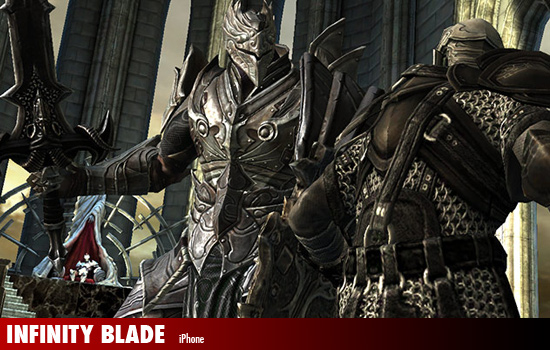
Publisher: Epic Games
Developer: Chair
MSRP: $6.99
by: Marc "DjinniMan" Allie
“Phone games” are not exactly regarded highly by most gamers. Sure, Tetris clones and Tower Defense variants are decent ways to pass time waiting in the doctor’s office, but usually expectations are pretty low. The iPhone and other iOS devices are changing that somewhat, but the field is still dominated by casual games. Infinity Blade, though, might be the game that changes everything.
It’s tough to classify Infinity Blade. It is a weapon-based action/fighting game, with light RPG elements, but the touch screen controls make it feel different than anything I’ve ever played. The main character is a nameless warrior who fights his way through an ancient castle. A handful of minions bar the way, but soon, the player confronts the God King. The God King is extremely powerful, so the protagonist dies horribly. A generation later, a new warrior advances to the castle, eager to avenge his father’s death. And so the cycle repeats. The story is bizarre at best and corny at worst, but I found it suitable for a game that is likely played in short bursts here and there.
 So how is the cycle of death broken? Each time a warrior dies, his attributes and items are passed on to his progeny. Level, armor, hit points, and magical skills carry over from one generation to the next. With each pass through the castle, the player becomes more and more powerful, but so too do the God King’s minions. Eventually, the God King will fall... but you’ll need to learn some new tricks to take him down.
So how is the cycle of death broken? Each time a warrior dies, his attributes and items are passed on to his progeny. Level, armor, hit points, and magical skills carry over from one generation to the next. With each pass through the castle, the player becomes more and more powerful, but so too do the God King’s minions. Eventually, the God King will fall... but you’ll need to learn some new tricks to take him down.
As the game progresses, you earn money which can be used to purchase better equipment. Armor, helmets, rings, and all sorts of weapons are available to you. Each item can be mastered by using it in combat, but once you have maxed out the weapon, you no longer gain experience from it. This provides some interesting decision making in what is otherwise a fairly straightforward system.
The meat of Infinity Blade is the combat. Weapon strikes are activated by swiping the screen, while dodges and blocks are controlled by tapping the screen in certain locations. Parrying is particularly fun, as you have to swipe in the opposite direction of an incoming attack. Spells can be cast by tracing patterns on the screen, if you have the proper items equipped. I found the combat to be natural and at the same time a bit challenging. A fast flurry of strikes may work fine for a while, but eventually you’ll need to choose your actions carefully depending on the methods of your foe.
Infinity Blade is easily the iOS game that is most like a console game. Were it not for the intuitive touch-screen specific control scheme, it could be mistaken for an Xbox 360 or PS3 title. Graphically, Infinity Blade has no equal, running beautifully on the Unreal Engine 3. For anyone who owns a compatible device, it is absolutely worth picking up. It’s the closest thing out there to a rich console experience on a handheld device.
Score: 